Abstract
Triple A syndrome is named after the main symptoms of alacrima, achalasia, and adrenal insufficiency but also presents with a variety of neurological impairments. To investigate the causes of progressive neurodegeneration, we examined the oxidative status of fibroblast cultures derived from triple A syndrome patients in comparison to control cells. Patient cells showed a 2.1-fold increased basal level of reactive oxygen species (ROS) and a massive boost after induction of artificial oxidative stress by paraquat. We examined the expression of the ROS-detoxifying enzymes superoxide dismutase 1 and 2 (SOD1, SOD2), catalase, and glutathione reductase. The basal expression of SOD1 was significantly (1.3-fold) increased, and the expression of catalase was 0.7-fold decreased in patient cells after induction of artificial oxidative stress. We show that the mitochondrial network is 1.8-fold more extensive in patient cells compared to control fibroblasts although the maximal ATP synthesis was unchanged. Despite having the same energy potential as the controls, the patient cells showed a 1.4-fold increase in doubling time. We conclude that fibroblasts of triple A patients have a higher basal ROS level and an increased response to artificially induced oxidative stress and undergo “stress-induced premature senescence”. The increased sensitivity to oxidative stress may be a major mechanism for the neurodegeneration in triple A syndrome.



Similar content being viewed by others
References
Allgrove J, Clayden GS, Grant DB, Macaulay JC (1978) Familial glucocorticoid deficiency with achalasia of the cardia and deficient tear production. Lancet 1:1284–1286
Moore PS, Couch RM, Perry YS, Shuckett EP, Winter JS (1991) Allgrove syndrome: an autosomal recessive syndrome of ACTH insensitivity, achalasia and alacrima. Clin Endocrinol 34:107–114
Dumić M, Radica A, Sabol Z, Plavsić V, Brkljacić L, Sarnavka V, Vuković J (1991) Adrenocorticotropic hormone insensitivity associated with autonomic nervous system disorders. Eur J Pediatr 150:696–699
Grant DB, Barnes ND, Dumic M, Ginalska-Malinowska M, Milla PJ, von Petrykowski W, Rowlatt RJ, Steendijk R, Wales JH, Werder E (1993) Neurological and adrenal dysfunction in the adrenal insufficiency/alacrima/achalasia (3A) syndrome. Arch Dis Child 68:779–782
Tullio-Pelet A, Salomon R, Hadj-Rabia S, Mugnier C, de Laet MH, Chaouachi B, Bakiri F, Brottier P, Cattolico L, Penet C et al (2000) Mutant WD-repeat protein in triple-A syndrome. Nat Genet 26:332–335
Handschug K, Sperling S, Yoon SJ, Hennig S, Clark AJ, Huebner A (2001) Triple A syndrome is caused by mutations in AAAS, a new WD-repeat protein gene. Hum Mol Genet 10:283–290
Cronshaw JM, Krutchinsky AN, Zhang W, Chait BT, Matunis MJ (2002) Proteomic analysis of the mammalian nuclear pore complex. J Cell Biol 158:915–927
Cronshaw JM, Matunis MJ (2003) The nuclear pore complex protein ALADIN is mislocalized in triple A syndrome. Proc Natl Acad Sci USA 100:5823–5827
Krumbholz M, Koehler K, Huebner A (2006) Cellular localization of 17 natural mutant variants of ALADIN protein in triple A syndrome—shedding light on an unexpected splice mutation. Biochem Cell Biol 84:243–249
Basel-Vanagaite L, Muncher L, Straussberg R, Pasmanik-Chor M, Yahav M, Rainshtein L, Walsh CA, Magal N, Taub E, Drasinover V et al (2006) Mutated nup62 causes autosomal recessive infantile bilateral striatal necrosis. Ann Neurol 60:214–222
Zhang X, Chen S, Yoo S, Chakrabarti S, Zhang T, Ke T, Oberti C, Yong SL, Fang F, Li L et al (2008) Mutation in nuclear pore component NUP155 leads to atrial fibrillation and early sudden cardiac death. Cell 135:1017–1027
Neilson DE, Adams MD, Orr CM, Schelling DK, Eiben RM, Kerr DS, Anderson J, Bassuk AG, Bye AM, Childs AM et al (2009) Infection-triggered familial or recurrent cases of acute necrotizing encephalopathy caused by mutations in a component of the nuclear pore, RANBP2. Am J Hum Genet 84:44–51
Hirano M, Furiya Y, Asai H, Yasui A, Ueno S (2006) ALADINI482S causes selective failure of nuclear protein import and hypersensitivity to oxidative stress in triple A syndrome. Proc Natl Acad Sci USA 103:2298–2303
Storr HL, Kind B, Parfitt DA, Chapple JP, Lorenz M, Koehler K, Huebner A, Clark AJ (2009) Deficiency of ferritin heavy-chain nuclear import in triple a syndrome implies nuclear oxidative damage as the primary disease mechanism. Mol Endocrinol 23:2086–2094
Kiriyama T, Hirano M, Asai H, Ikeda M, Furiya Y, Ueno S (2008) Restoration of nuclear-import failure caused by triple A syndrome and oxidative stress. Biochem Biophys Res Commun 374:631–634
Lin MT, Beal MF (2006) Mitochondrial dysfunction and oxidative stress in neurodegenerative diseases. Nature 443:787–795
Sas K, Robotka H, Toldi J, Vécsei L (2007) Mitochondria, metabolic disturbances, oxidative stress and the kynurenine system, with focus on neurodegenerative disorders. J Neurol Sci 257:221–239
Andréasson H, Gyllensten U, Allen M (2002) Real-time DNA quantification of nuclear and mitochondrial DNA in forensic analysis. Biotechniques 33:402–411
Jacobson J, Duchen MR, Heales SJ (2002) Intracellular distribution of the fluorescent dye nonyl acridine orange responds to the mitochondrial membrane potential: implications for assays of cardiolipin and mitochondrial mass. J Neurochem 82:224–233
Cossarizza A, Salvioli S (2001) Flow cytometric analysis of mitochondrial membrane potential using JC-1. Curr Protoc Cytom 9.14
Manfredi G, Spinazzola A, Checcarelli N, Naini A (2001) Assay of mitochondrial ATP synthesis in animal cells. Methods Cell Biol 65:133–145
Feissner RF, Skalska J, Gaum WE, Sheu SS (2009) Crosstalk signaling between mitochondrial Ca2+ and ROS. Front Biosci 14:1197–1218
St-Pierre J, Buckingham JA, Roebuck SJ, Brand MD (2002) Topology of superoxide production from different sites in the mitochondrial electron transport chain. J Biol Chem 277:44784–44790
Koehler K, Brockmann K, Krumbholz M, Kind B, Bönnemann C, Gärtner J, Huebner A (2008) Axonal neuropathy with unusual pattern of amyotrophy and alacrima associated with a novel AAAS mutation p.Leu430Phe. Eur J Hum Genet 16:1499–1506
Khelif K, De Laet MH, Chaouachi B, Segers V, Vanderwinden JM (2003) Achalasia of the cardia in Allgrove’s (triple A) syndrome: histopathologic study of 10 cases. Am J Surg Pathol 27:667–672
Silver I, Erecińska M (1998) Oxygen and ion concentrations in normoxic and hypoxic brain cells. Adv Exp Med Biol 454:7–16
Kann O, Kovács R (2007) Mitochondria and neuronal activity. Am J Physiol Cell Physiol 292:C641–C657
Baron M, Kudin AP, Kunz WS (2007) Mitochondrial dysfunction in neurodegenerative disorders. Biochem Soc Trans 35:1228–1231
Hayflick L, Moorhead PS (1961) The serial cultivation of human diploid cell strains. Exp Cell Res 25:585–621
Toussaint O, Remacle J, Dierick JF, Pascal T, Frippiat C, Zdanov S, Magalhaes JP, Royer V, Chainiaux F (2002) From the Hayflick mosaic to the mosaics of ageing. Role of stress-induced premature senescence in human ageing. Int J Biochem Cell Biol 34:1415–1429
Lee HC, Yin PH, Chi CW, Wei YH (2002) Increase in mitochondrial mass in human fibroblasts under oxidative stress and during replicative cell senescence. J Biomed Sci 9:517–526
Lee HC, Wei YH (2007) Oxidative stress, mitochondrial DNA mutation, and apoptosis in aging. Exp Biol Med 232:592–606
Passos JF, Saretzki G, Ahmed S, Nelson G, Richter T, Peters H, Wappler I, Birket MJ, Harold G, Schaeuble K et al (2007) Mitochondrial dysfunction accounts for the stochastic heterogeneity in telomere-dependent senescence. PLoS Biol 5:e110
Tamm I, Kikuchi T, Wang E, Pfeffer LM (1984) Growth rate of control and beta-interferon-treated human fibroblast populations over the course of their in vitro life span. Cancer Res 44:2291–2296
Brown WM, George M Jr, Wilson AC (1979) Rapid evolution of animal mitochondrial DNA. Proc Natl Acad Sci USA 76:1967–1971
Acknowledgments
We gratefully acknowledge Sandra Jackson from the Clinic of Neurology of the Technical University Dresden, Germany and Markus Schuelke from the Department of Neuropaediatrics of the Charité University Medicine, Berlin, Germany for the methodical help and fruitful discussions. This work was supported by a grant of the Deutsche Forschungsgemeinschaft (DFG, HU895 3/3–5) to AH and a MeDDrive grant of the Medical Faculty of the Technical University Dresden, Germany to KK.
Disclosure of potential conflict of interests
The authors declare no conflict of interests related to this study.
Author information
Authors and Affiliations
Corresponding author
Rights and permissions
About this article
Cite this article
Kind, B., Koehler, K., Krumbholz, M. et al. Intracellular ROS level is increased in fibroblasts of triple A syndrome patients. J Mol Med 88, 1233–1242 (2010). https://doi.org/10.1007/s00109-010-0661-y
Received:
Revised:
Accepted:
Published:
Issue Date:
DOI: https://doi.org/10.1007/s00109-010-0661-y




